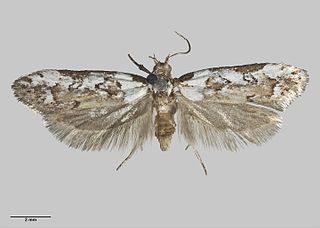
Callenya melaena, the metallic hedge blue, is a small butterfly found in India that belongs to the lycaenids or blues family.

Prosotas nora, the common lineblue, is a species of lycaenid butterfly found in Asia to Australia. The species was first described by Rudolf Felder in 1860.

Nacaduba berenice, the rounded six-line blue, is a lycaenid butterfly found in Indomalayan realm. The species was first described by Gottlieb August Wilhelm Herrich-Schäffer in 1869.

Amblypodia anita, the purple leaf blue or leaf blue, is a lycaenid or blue butterfly found in South Asia and Southeast Asia, including Sri Lanka, India, Myanmar, Malaysia, and Java. The species was first described by William Chapman Hewitson in 1862.

Notocelia uddmanniana, the bramble shoot moth, is a moth of the family Tortricidae. It is found in Western Europe and the area surrounding the Mediterranean Sea all the way up to the Caucasus, Kazakhstan, Iran and China.

Anarta myrtilli, the beautiful yellow underwing, is a moth in the family Noctuidae. The species was first described by Carl Linnaeus in 1761. It is found in most of Europe including Scandinavia, Britain, France, Germany, Switzerland, Spain, Portugal, Italy, and Russia.
Pyrrhia victorina is a moth of the family Noctuidae. It is found in Bulgaria, Greece, Romania, Slovenia, former Yugoslavia and Daghestan.
Licigena is a monotypic genus of moths belonging to the subfamily Olethreutinae of the family Tortricidae. Its sole species is Licigena sertula, which has been found in Sri Lanka. Both the genus and species were first described by Alexey Diakonoff in 1982.

Nycteola revayana, the oak nycteoline, is a moth of the family Nolidae. The species was first described by Giovanni Antonio Scopoli in 1772. It is found from Europe and east across the Palearctic to Japan and India.

Caryocolum fraternella is a moth of the family Gelechiidae. It is found in Ireland, Great Britain, Fennoscandia, Denmark, Germany, the Netherlands, France, Switzerland, Spain, Latvia, Estonia and Ukraine.
Grapholita amphitorna is a species of moth of the family Tortricidae. It is found in Australia, where it has been recorded from Queensland.
Exaeretia sordidella is a moth in the family Depressariidae. It is found in North America, where it has been recorded from British Columbia.
Brachmia custos is a moth in the family Gelechiidae. It was described by Edward Meyrick in 1911. It is found in southern India.
Epiphractis rubricata is a moth of the family Oecophoridae first described by Edward Meyrick in 1913. This species was described from Pretoria and Pinetown in South Africa.
Gonionota hyptiotes is a moth in the family Depressariidae. It was described by Clarke in 1964. It is found in Mexico.
Imma tetrope is a moth in the family Immidae. It was described by Alexey Diakonoff in 1978. It is found in Nepal.

Hierodoris stella is a species of moth in the family Oecophoridae. This species is endemic to New Zealand and occurs in Auckland, Taranaki, Hawkes Bay, Bay of Plenty and Wellington. As at 2005 the larvae of this species is unknown as is its host plant. The adult moth frequents forest and are on the wing in January and February. It is classified as "At Risk, Relict'" by the Department of Conservation.

Trachypepla festiva is a moth of the family Oecophoridae and was first described by Alfred Philpott in 1930. It is endemic to New Zealand and has been collected in the northern parts of the North Island.

Cydia coniferana is a Palearctic moth belonging to the family Tortricidae. The species was first described by Saxesen in 1840. The wingspan is 11-13 mm. The forewings are dark fuscous, the costa posteriorly with white strigulae, some ending in obscure leaden-metallic marks. There is an irregular erect white dorsal median spot, including a dark fuscous strigula. The ocellus is edged with leaden-metallic, and crossed by several black dashes. The hindwings are fuscous. The larva is dull yellowish ; head pale brown

Tingena chrysogramma is a species of moth in the family Oecophoridae. It is endemic to New Zealand and is found in the North and South Islands. The adults of this species inhabits open scrubland and are on the wing in January and February. It has been collected via light traps and beating shrubs. During sunny days this species has been observed resting on leaves and rarely flies. It is regarded as a rare species and has a possible association with Prumnopitys ferruginea.










